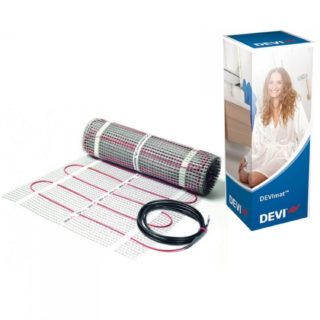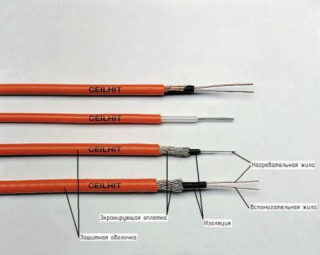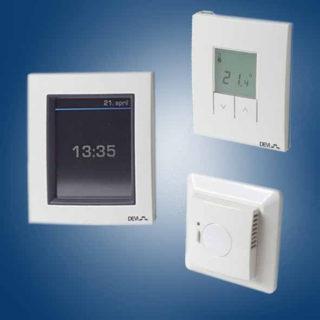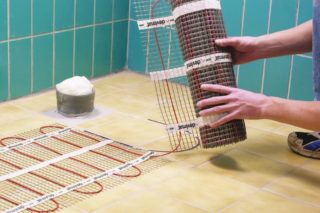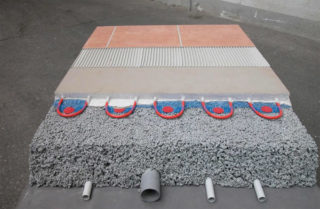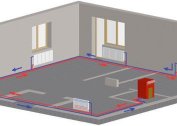Universal Devi floor heating is very popular due to its high level of quality, convenience and reliability. The brand system helps to solve the problem of heating the floor covering and is able to create the most comfortable climate in the room. The brand’s floor is recognized as one of the safest and most environmentally friendly, which confirms that it has an ISO 14001 certificate. Before installing the system, it will be useful to study its features, advantages and disadvantages, as well as installation technology.
Characteristics
The heating mat of the Devi system is a system with a self-adhesive base, inside of which there are wires with two cores or one. It is supplemented by regulators and sensors, with which you can change power and prevent overheating. Mats are easy to install, suitable for installation under tiles, laminate or any other coating. The main advantage of the Devimat system is that everyone can install it, this does not require special skills.
Mats can heat up to 80 degrees and are great for installing underfloor heating in houses and apartments, office rooms, country houses and country cottages, as well as technical-type buildings. They are available in the form of convenient rolls that can be cut, this allows you to easily lay mats in rooms even with a non-standard layout. Additional special equipment from Davy, including regulators, thermostats with an LCD display and connecting elements, go well with modern heating systems.
The Devi system is able to heat a house in a short period of time without the additional cost of electricity. A special thermostat for heated floors Devi is able to automatically adjust the temperature and prevent its sudden changes. You can control the system using a PC or in the traditional way, which allows you to set different temperatures in each room and connect additional options. Suitable for families with small children.
The manufacturer provides a maximum warranty of up to 10-20 years, but in reality the system can last much longer without failures.
Types of cables
The manufacturer produces the Devimat system of three varieties - DSVF, DTIR and DTIF, which differ from each other in the type of cable. DCVF is considered a classic option since it has been manufactured since 1996. These mats are based on a thin single-core cable 2.5 mm fastened with a self-adhesive mesh, its power is 150 W / m2. They are suitable only for residential premises, have an inner and outer insulation layer, do not require tight screed during installation. On sale are DCVF mats for areas from 0.5 to 10 m2.
Type DTIR is available since 2013. Such mats work on a 4.5 mm twin-core cable with a power of 137 W / m2, have double-layer PVC insulation and can be used both in residential and commercial premises, including balconies and loggias. They do not require a base with a thick screed.
A variation of DTIF works with a thinner 3 mm two-core cable, these mats are equipped with double PVDF insulation and solid screens. They can only be used indoors on floors without a thick screed.
Cables of a single-core, two-core resistive and self-regulating type are used not only when installing a warm floor from Devi.They are suitable for pipelines, thermal energy storage systems, greenhouses, heating systems for porches, outdoor areas and lawns.
Resistive cables cannot be cut because they have a special structure and consist of a heating core with a braid and a sheath. Self-regulating can be cut if necessary, they also help save energy, as they adjust to the temperature inside the room.
The main element of Devimat floors of any type is the special Devireg thermostat, which independently activates and deactivates the heating option. Additionally, users can connect an autonomous power source, temperature sensor, child protection and other options to the floor.
Single core
DSIG single core cables can be used indoors and outdoors. They are sold in the form of segments of various lengths, have a simple structure and are characterized by low cost. The price of a segment 9 meters long does not exceed 3000 rubles.
Two-core
The two-core DTIP type cables are equipped with PVC insulation and can be used indoors when it comes to installing a full-fledged heating system. They are also suitable for outdoor use, including on ramps and stairs. Their power does not exceed 10-18 W / m. On sale they are also presented in the form of segments. The cost of 10 m starts at 3,100 rubles.
Twin core with special insulation
DTIE type twin-core cables have a special Polyolefin insulation, which greatly simplifies the installation procedure. The manufacturer refers them to environmentally friendly materials, so they can be used to install underfloor heating systems in medical institutions, kindergartens and schools. Such cables are sold in sections from 9 to 170 m long. The minimum will cost from 2600 rubles.
Principle of operation
The cable floor Devi is considered the most comfortable and easy to use due to the unique principle of operation. After connecting the system, the cable transfers heat energy to the coating, which is a heat exchanger. This process provides air heating and optimizes indoor temperature. The Devi floor heating controller receives temperature data from the sensor, then, depending on its value, the current is supplied to the system of the desired value, heating the floor. When the air warms up to the required temperature, the power will be turned off automatically.
If the temperature drops, the whole process will start from the very beginning. For mats, temperature regulators of the Devilink model are most often used, with their help you can control the entire surface heating system, including sensors, a radiator and a boiler. Energy during the operation of the floor covering will be consumed taking into account the set temperature value.
The floor is able to warm up evenly for ten minutes. The temperature value will depend on how correctly the coating is installed. To avoid possible errors, before installation you need to study the operating instructions in detail.
Advantages of Devi Underfloor Heating
Warm electric floors Devimat have many advantages and stand out against the counterparts from other manufacturers. Buyers note their improved characteristics, quality of materials, ease of use and during installation, durability and maximum reliability. The list of the main advantages of the system includes:
- the ability to uniformly warm the entire area of the room during one heating cycle;
- energy savings through thermostats, which can save up to 25% of the total payments in the cold season;
- the ability to use the system at any time, regardless of the operation of central heating;
- combination of the system with any type of flooring;
- the ability to warm up the entire room, as well as a separate area;
- the most simple installation;
- lack of additional system maintenance costs.
The system is suitable for interiors of any type, since it is completely hidden under the floor. It does not violate the style of the room and can be combined with all types of floor coverings.
Calculation and installation
Installation of Devi floors does not cause problems, each person who has previously studied the operating instructions can cope with the installation. When installing under a tile, only DEVflex cables with a power of up to 20 W / m are used. For residential premises, cables with a capacity of up to 100 W per square meter will be sufficient, for bathrooms and toilets - up to 120 W.
During installation, additional special tools will not be required, in addition to the system, mounting tape and corrugations will be enough. Before laying the cable, a concrete screed is prepared, the thickness of which should not exceed three centimeters under the wires. Equipment cannot be laid in places where large furniture will stand. Between the individual threads observe the distance, which depends on the type of heating system. For the full step is 7.5-10 cm, for the auxiliary to 15 cm.
The degree of heating of a room depends on proper thermal insulation, especially if it is located on the ground floor or above the basement. Expanded clay screed, foam type polypropylene or a roll cork backing are usually used as heat insulating materials.
In addition to thermal insulation, they necessarily use a polypropylene mesh or lavsan, which is placed on top of the mats. In rooms with a high level of humidity, an additional waterproofing layer is created located above the cable.
Technology and flooring Devimat
All floors of Devimat work on the same technology, which is based on the electrical resistance of metals. Due to the heating of electricity, heat goes up and enters the air, which evenly warms up after a while and creates the optimal temperature regime inside the room. The construction of this type of floor is not difficult and consists of soil, foundation, thermal and waterproofing, supplemented with mounting tape, heating cable and cable ties. For mats, it is necessary to install a temperature controller from Devi for a warm floor.
